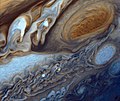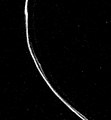Voyager 1

The Voyager 1 spacecraft is a 733-kilogram robotic space probe of the outer solar system and beyond, launched September 5, 1977, and currently operational. It visited Jupiter and Saturn and was the first probe to provide detailed images of the moons of these planets.
Voyager 1 is the farthest human-made object from Earth, traveling away from both the Earth and the Sun at a relatively faster speed than any other probe. Though its sister-craft, Voyager 2, was launched one month earlier, Voyager 2 will never pass Voyager 1. Neither will the New Horizons mission to Pluto, despite being launched from Earth at a faster speed than both Voyager craft, since during its flight Voyager 1 benefited from a number of gravity assisted speed boosts.[1]
As of August 10, 2007, Voyager 1 is over 15.49 terameters (15.49×1012 meters, or 15.49×109 km, 103.6 AU, or 9.6 billion miles) from the Sun, and has thus entered the heliosheath, the termination shock region between the solar system and interstellar space, a vast area where the Sun's influence gives way to the other bodies in the galaxy. If Voyager 1 is still functioning when it finally passes the heliopause, scientists will get their first direct measurements of the conditions in the interstellar medium. At this distance, signals from Voyager 1 take more than thirteen hours to reach its control center at the Jet Propulsion Laboratory, a joint project of NASA and Caltech near Pasadena, California. Voyager 1 is on a hyperbolic trajectory and has achieved escape velocity, meaning that its orbit will not return to the inner solar system. Along with Pioneer 10, Pioneer 11, New Horizons, and Voyager 2, Voyager 1 is an interstellar probe.
Voyager 1 had as its primary targets the planets Jupiter and Saturn and their associated moons and rings; its current mission is the detection of the heliopause and particle measurements of solar wind and the interstellar medium. Both Voyager probes are powered by three radioisotope thermoelectric generators, which have far outlasted their originally intended lifespan, and are now expected to continue to generate enough power to keep communicating with Earth until at least around the year 2020.
Mission profile

Voyager 1 was originally planned as Mariner 11 of the Mariner program. From the outset, it was designed to take advantage of the then-new technique of gravity assist. Luckily, the development of interplanetary probes coincided with an alignment of the planets called the Grand Tour. The Grand Tour was a linked series of gravity assists that, with only the minimal fuel needed for course corrections, would enable a single probe to visit all four of the solar system's gas giant planets: Jupiter, Saturn, Uranus and Neptune. The identical Voyager 1 and Voyager 2 probes were designed with the Grand Tour in mind, and their launches were timed to enable the Grand Tour if desired.
Because of this alignment, Voyager could visit each of these planets in just twelve years, instead of the 30 that would usually be required.
Voyager 1 was launched on September 5, 1977 by NASA from Cape Canaveral aboard a Titan IIIE Centaur rocket, shortly after its sister craft, Voyager 2 on August 20, 1977. Despite being launched after Voyager 2, Voyager 1 was sent on a faster trajectory so it reached Jupiter and Saturn before its sister craft.
Initially, an underburn in the second stage of the Titan IIIE rocket left an estimated one second's worth of fuel remaining in that stage. Although ground crews were worried that Voyager 1 would not make it to Jupiter, the Centaur upper stage proved to have enough fuel to compensate.
For details on the Voyager instrument packages, see the separate article on the Voyager program.
Jupiter
Voyager 1 began photographing Jupiter in January 1979. Its closest approach to Jupiter was on March 5, 1979, at a distance of 349,000 kilometers (217,000 miles) from its center. Due to the greater resolution allowed by close approach, most observations of the moons, rings, magnetic fields, and radiation environment of the Jupiter system were made in the 48-hour period bracketing closest approach. It finished photographing the planet in April.
The two Voyager spacecraft made a number of important discoveries about Jupiter and its satellites. The most surprising was the existence of volcanic activity on Io, which had not been observed from the ground or by Pioneer 10 or 11.
-
Voyager 1 time lapse movie of Jupiter approach.
-
The Great Red Spot as seen from Voyager 1.
-
Color picture of Io, Jupiter's innermost Galilean satellite.
-
False color detail of Jupiter's atmosphere, as imaged by Voyager 1.
-
Valhalla crater on Callisto. Image taken by Voyager 1 in 1979.
Saturn
The gravity assist at Jupiter was successful, and the spacecraft went on to visit Saturn. Voyager 1's Saturn flyby occurred in November 1980, with the closest approach on November 12 when it came within 124,000 kilometers (77,000 miles) of the planet's cloud-tops. The craft detected complex structures in Saturn's rings, and studied the atmospheres of Saturn and Titan. Because of the earlier discovery of a thick atmosphere on Titan, the Voyager controllers at the Jet Propulsion Laboratory elected for Voyager 1 to make a close approach of Titan and terminate its Grand Tour. (For the continuation of the Grand Tour, see the Uranus and Neptune sections of the Voyager 2 article.) The Titan-approach trajectory caused an additional gravity assist that took Voyager 1 out of the plane of the ecliptic, thus ending its planetary science mission.
-
Voyager 1 image of Saturn from 5.3 million km, four days after its closest approach.
-
Layers of haze covering Saturn's satellite Titan.
-
Titan's thick haze layer is shown in this enhanced Voyager 1 image.
-
Voyager 1 image of Saturn's F ring.
Interstellar mission
It is estimated that both Voyager craft have sufficient electrical power to operate at least some instruments until 2020.
| Year | End of specific capabilities as a result of the available electrical power limitations |
|---|---|
| 2003 | Terminate scan platform and UV observations |
| ~2010 | Termination of gyro operations |
| ~2010 | Termination of DTR operations (limited by ability to capture 1.4 kbit/s data using a 70 m/34 m antenna array) |
| ~2016 | Initiate instrument power sharing |
| > 2020 | Can no longer power any single instrument |
Heliopause

As Voyager 1 heads for interstellar space, its instruments continue to study the solar system; Jet Propulsion Laboratory scientists are using the plasma wave experiments aboard Voyager 1 and 2 to look for the heliopause.
Scientists at the Johns Hopkins University Applied Physics Laboratory believe that Voyager 1 entered the termination shock in February 2003.[2] Some other scientists have expressed doubt, discussed in the journal Nature of November 6 2003. In a scientific session at the American Geophysical Union meeting in New Orleans on the morning of May 25 2005, Dr. Ed Stone presented evidence that Voyager 1 crossed the termination shock in December 2004. "SH22A-01" The issue will not be resolved for some months as other data become available, since Voyager's solar-wind detector ceased functioning in 1990. However, in May 2005 a NASA press release said that consensus was that Voyager 1 was now in the heliosheath.[3] Scientists believe the craft will reach the heliopause in 2015.
Current status
As of August 22, 2007, Voyager 1 was at a distance of 103.6 AU (approximately 15.5 terameters, 9.7 billion miles or 0.0016 light years) from the Sun, which makes it the most distant human-made object from Earth.[4] At this distance, it is more distant from the Sun than any known natural solar system object, including 90377 Sedna. Though Sedna has an orbit that takes it 975 AU away from the Sun at aphelion, as of 2006 it is less than 90 AU away from the Sun and approaching its perihelion at 76 AU.[5][6]

At its current distance, light (which travels at 186,282.397 miles per second or 299,792.458 kilometers per second) takes over 13.8 hours to reach the spacecraft from Earth. As a basis for comparison, the Moon is about 1.4 light seconds from Earth, the Sun is about 8.5 light minutes away, and Pluto is at an average distance of approximately 5.5 light hours. As of November 2005, the spacecraft was traveling at a speed of 17.2 kilometers per second relative to the sun (3.6 AU per year or 38,400 miles per hour), 10% faster than Voyager 2. Accurate information concerning its location can be found in this NASA paper with heliocentric coordinates extrapolated up to 2015 of both probes.
Voyager 1 is not heading towards any particular star, but in 40,000 years it will be within 1.7 light years of the star AC+793888 in the Camelopardis constellation.
On March 31 2006, the amateur radio operators from AMSAT Germany tracked and received data from Voyager 1 using the 20-metre (66 ft) dish at Bochum with a long integration technique. Its data were checked and verified against data from the Deep Space Network station at Madrid, Spain.[7] This is believed to be the first such tracking of Voyager.
Voyager 1, as of September 2006, is at 12.22° declination and 17.051 hours right ascension, placing it in the constellation Ophiuchus. NASA continues daily tracking of the spacecraft with the Deep Space Network stations.
See also
- Voyager program
- Voyager Golden Record
- Voyager 2
- Pioneer 10
- Pioneer 11
- Pale Blue Dot
- Family Portrait (Voyager)
References
- ^ "New Horizons Salutes Voyager". New Horizons. August 17, 2006. Retrieved 2007-08-07.
- ^ Kate Tobin (November 5, 2003). "Spacecraft reaches edge of solar system". CNN.com. Retrieved 2007-08-07.
- ^ "Voyager Enters Solar System's Final Frontier". NASA. May 24, 2005. Retrieved 2007-08-07.
- ^ Pioneering NASA Spacecraft Mark Thirty Years of Flight Aug 20, 2007, Week Ending March 9 2007
- ^ CNN: "NASA: Voyager I enters solar system's final frontier", May 25, 2005
- ^ CNN: "NASA: Voyager II detects solar system's edge", May 23, 2006
- ^ AMSAT-DL article in German; ARRL article in English
External links
- NASA Voyager website
- Voyager Spacecraft Lifetime — interstellar mission coverage.
- Voyager 1 Mission Profile by NASA's Solar System Exploration
- Spacecraft Escaping the Solar System — current positions and diagrams
- Weekly Mission Reports — includes information on current spacecraft state
- We Are Here: The Pale Blue Dot. A short film on The Pale Blue Dot picture taken by Voyager. Narrated by Carl Sagan.











